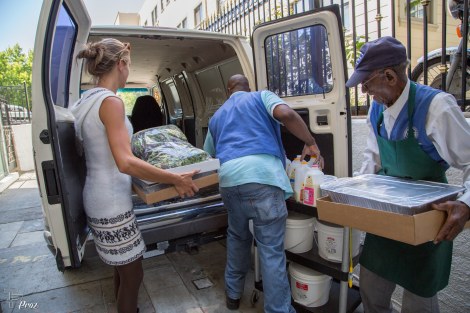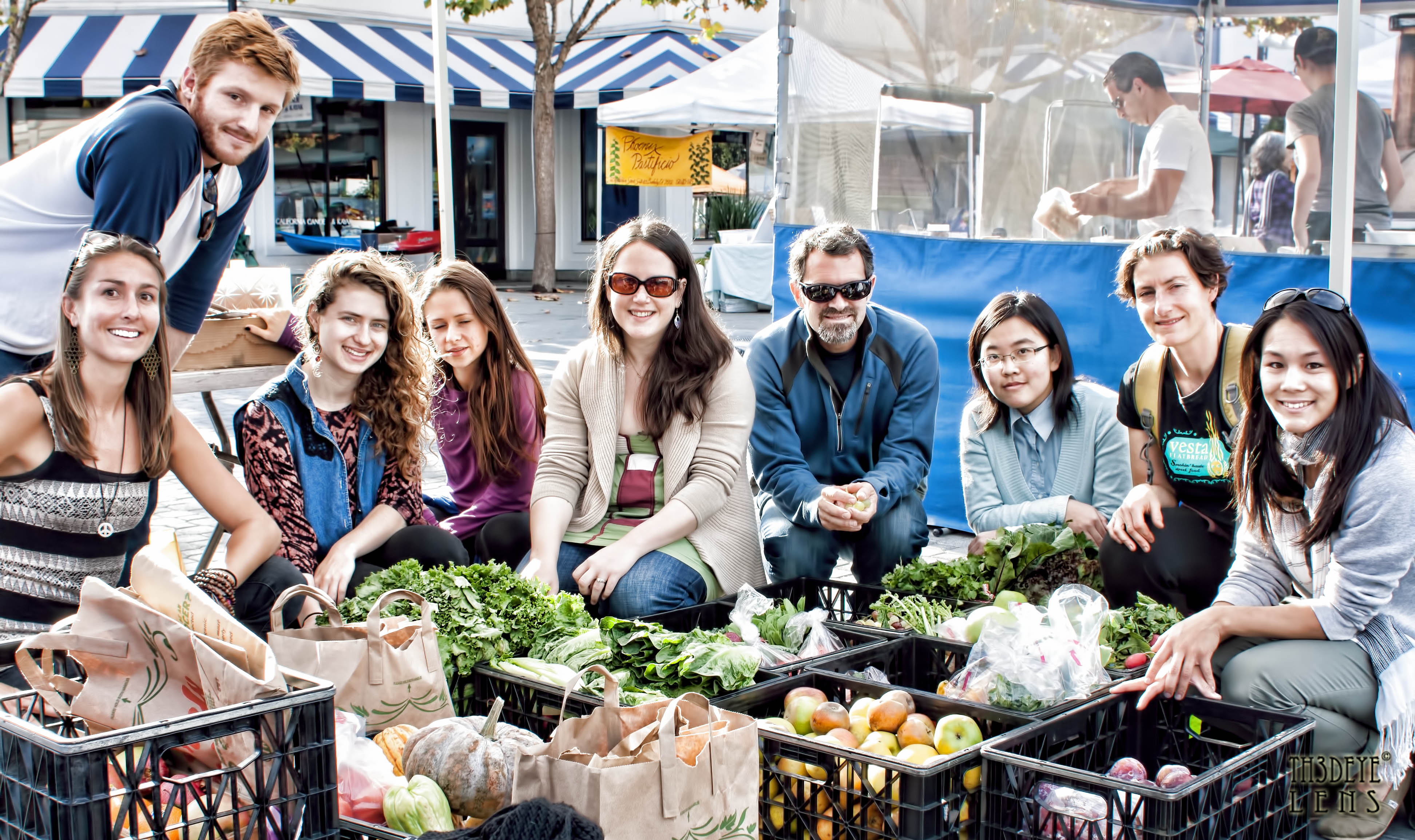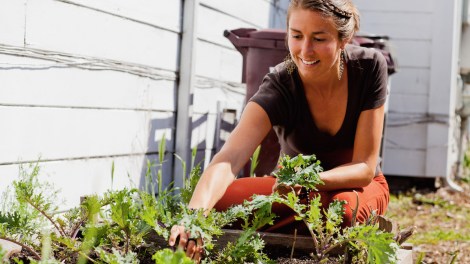Dana Frasz was first introduced to widespread endemic poverty while volunteering in Southeast Asia more than a decade ago. The malnourishment she encountered, especially among children, left a deeper impression on her than the beautiful landscape.
Returning home to Maine, and while attending college at both the Rochester Institute of Technology and Sarah Lawrence College, Frasz found herself acutely aware of the tremendous variety and quantity of food everywhere she went – and yet, much of it was being thrown away.
“Witnessing tray after tray of perfectly good food being dumped down the garbage disposal in my college dining hall is what brought me to want to learn and act on the issue on a larger level,” she says.
There was no lack of work to be done. The average American household tosses a quarter of the food it brings home. Retailers throw out bruised or misshapen produce and day-old baked goods. Catering companies are left with trays of untouched gourmet cuisine.
Those discards add up. The United Nations estimates that one-third of all food worldwide is wasted. In the U.S. alone, over 33 million tons of it was sent to landfills in 2010 — enough to fill the Rose Bowl stadium every day for a year.
The environmental impacts of this wasted food are vast. Only 3 percent of food scraps in the U.S. are converted to compost. The rest go to the dump, where they rot and release methane, a greenhouse gas that second only to carbon dioxide as a contributor to climate disruption.
If global food waste were a country, it would be the third largest greenhouse gas polluter in the world, behind only China and the United States – and that’s not counting the greenhouse gases that were created during the production of all that uneaten food.
But Frasz, along with a growing number of individuals, nonprofits, and religious organizations have set out to stop this waste. They are gleaners, repurposing the unwanted food to feed hungry people, and fighting climate change at the same time.
“Gleaning is simply the act of collecting excess fresh foods from farms, gardens, farmers markets, grocers, restaurants, state/county fairs, or any other sources in order to provide it to those in need,” the U.S. Department of Agriculture states in its “Let’s Glean!” toolkit, developed to assist groups with food recovery.
Driven by the paradox of desperate need and abundance existing side-by-side, Frasz, when still a Sophomore at Sarah Lawrence, established a food recovery program called Empty Bellies. The group collected over 500 pounds of leftover food every week from local businesses, college events, and the campus dining hall. By Frasz’s senior year, Empty Bellies had 45 volunteers who helped collect leftover food and deliver it to an agency serving low-income people in the Bronx called Part of the Solution.
While the initiative made great strides in reducing food waste and feeding the hungry, Frasz learned that using volunteers to solve such a large problem wasn’t enough. “It was completely volunteer-run, which was awesome,” she says. “But volunteers were inconsistent, which put us in a really tricky position with our business partners. If we didn’t show up one day, there was a lot of frustration and threats of canceling their donations.”
Empty Bellies thrived, but only for five years, disbanding shortly after Frasz graduated and moved away. Now living in the Bay Area, Frasz is working on a few innovative strategies to more effectively and sustainably reduce both food waste and hunger — and reduce the impact on the climate, too.
Frasz believes that the creation of a professional food recovery service sector is a necessary extension of our current waste management system, as well as a way to create jobs in the green economy. To that end, she has created a nonprofit called Food Shift, that works to demonstrate the social, financial, and environmental benefits of food recovery to businesses, municipalities, and public health departments, and encouraging these entities to invest in food recovery rather than food disposal.
“We’re paying people to remove our trash and we’re paying people to remove our recycling,” she says. “Why aren’t we paying people to recover this incredibly valuable resource of food?”

Food Shift
The U.S. spends $750 million each year to dispose of surplus food. What if we were to shift just a fraction of that toward the recovery and redistribution of food instead? Eradicating wasted food would reduce total U.S. methane emissions by 25 percent, significantly decreasing U.S. greenhouse gas emissions.
There are hundreds of volunteer groups like Empty Bellies across the country. Some have been around for decades and are lauded for their hard work and results in rescuing unwanted edibles. Yet, as the Natural Resources Defense Council reported in 2012, the U.S. still wastes 40 percent of the food we produce, while 50 million Americans are food-insecure.
Frasz believes that the realities of a strictly volunteer-run and charity-funded approach to food recovery prevent it from growing into a more sustainable and effective solution. “We’re tackling this burning issue of food waste and hunger as if we’re putting out a fire one bucket at a time, and its not working,” she says. “We need to invest in vehicles, refrigeration, storage, and paid employees in order to build a professional, efficient, sustainable system that can manage surplus food safely and effectively.”
It’s no easy task. Food safety rules require that precautions be taken when handling food meant for consumption. Perishables must be kept at the correct temperatures, and hands must be washed before and after handling certain items like poultry and other meats. Many restaurant and store owners fear that they’ll be held liable if surplus food donations make people sick.
Some remain unaware that federal and state law protects donors, and has for nearly 20 years. President Clinton signed the Bill Emerson Good Samaritan Food Donation Act in 1996. It protects donors from liability except in cases of gross negligence or intentional misconduct, as long as the food is given to a nonprofit that then distributes it to needy individuals.
With this assurance, many businesses can be coaxed to donate leftover food, but convincing businesses to pay Food Shift for the service is even more challenging, Frasz says, when many groups offer to do it for free.
But her group’s message finally seems to be getting through. Andronico’s Community Markets, a Bay Area grocery chain, is within weeks of finalizing a contract with Food Shift that would make it the nonprofit’s first regularly paying client.
“As a natural consequence of being a retailer and trying to keep the freshest product on the shelves, we’re forced to deal with product that we can’t sell to our customers,” says Chad Solari, director of produce and floral at Andronico’s. In the past, many unsellable items ended up in the landfill or a compost pile.
To avoid waste, Andronico’s donates excess products to food banks, religious organizations, and local charities. But while Solari feels that the programs serve the community fairly well, he says the system is inefficient. The volunteer pickup doesn’t come enough, or with the proper equipment, to prevent the majority of the surplus edibles from going to waste. It’s also tough for the staff to find time to prepare the food for donation.
“As our CEO says, ‘We need to find a way to have the biggest impact on our community while having the smallest impact on our associates, because they are very busy,’” Solari says.
The beauty of Food Shift, Solari says, is that the nonprofit will take care of everything, from the smallest logistical problem to tracking the donations and providing reports to document them. “They’re fully insured, they know all the protocols, and they’re very passionate about it,” Solari says. “That’s why it’s worth paying them a small fee. They’ll do it right.”
Frasz sees the contract with Andronico’s as a turning point. “This represents a big milestone for Food Shift and for food recovery more broadly,” she says. “We’re really starting to make the case that food recovery is a valuable and essential part of a just and sustainable food system, and one that businesses need to step up to the plate and take some responsibility for financially.”
As businesses begin to contract with professional groups like Food Shift, food recovery will more effectively chip away at the huge amount of wasted food and hunger in America, and reduce its many environmental impacts as well.
“This is such a solvable issue,” Frasz says. “Tackling it effectively will have ripple effects on these areas that are so important to the climate, to our communities, and to the world.”





